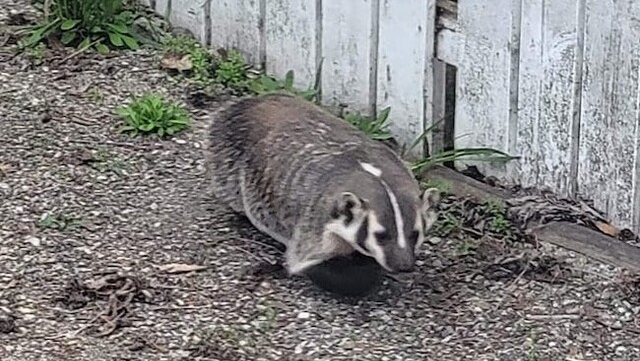Endangered B.C. badger spotted roaming residential neighbourhood
 In this photo, taken by Brodie Dranchuk and submitted to Castanet, a badger is shown in a residential area of a city in B.C.'s Okanagan region.
In this photo, taken by Brodie Dranchuk and submitted to Castanet, a badger is shown in a residential area of a city in B.C.'s Okanagan region.
A badger was caught on camera wandering a residential neighbourhood in B.C.'s Okanagan region, a rare sight given how few of the animals actually remain in the province.
According to Castanet, a resident of Vernon's BX district posted a photo of the endangered animal to a community Facebook group.
"Watch your pets and kids," Brodie Danchuk was reported to have written along with the picture.
There are only 250 of these large members of the weasel family estimated in all of B.C. , according to the Okanagan-Similkameen Stewardship Society. Of those, fewer than 30 are estimated to live in the Okanagan Valley.
The creatures are described by the society as "elusive," and "prefer to avoid human contact – making spotting one very unlikely. Instead, their presence is usually deduced by discovering upon a burrow
"Badgers are super diggers and can dig huge burrows up to nine metres long and up to three metres deep," the society notes.
When badgers move on, these burrows can provide nesting sites for to other endangered animals, like the burrowing owl.
There are several factors that threaten B.C.'s badger population, according to the society. First, their preferred habitats are also prime spots for development. Second, there's a scarcity of prey because they prefer to eat things like mice and other rodents that humans commonly consider pests. Rodenticides can kill badgers if they consume a rat or mouse that has been poisoned.
Badgers in BC, an organization dedicated to preserving the population, also notes the animals' particular vulnerability to being killed on highways. They tend to wander and their "home ranges" can span up to 50 square kilometres, so they can end up crossing highways or other roadways multiple times each day.
One of the things that conservationists say can be most helpful in protecting badgers is to report any sighting. Given how rare encountering one is, the following description might be helpful.
"They are mostly a grizzled greyish-tan all over and are clearly identifiable by their low, compact stature and the distinctive black-and-white stripes on their heads and face," says the Okanagan-Similkameen Stewardship Society's website, adding the creature gets its name from the black cheek "badges."
Any sightings of burrows or badgers should be reported online.
CTVNews.ca Top Stories

'Too young to have breast cancer': Rates among young Canadian women rising
Breast cancer rates are rising in Canada among women in their 20s, 30s and 40s, according to research by the University of Ottawa (uOttawa).
Sophie Gregoire Trudeau on navigating post-political life, co-parenting and freedom
Sophie Gregoire Trudeau says there is 'still so much love' between her and Prime Minister Justin Trudeau, as they navigate their post-separation relationship co-parenting their three children.
'I was scared': Ontario man's car repossessed after missing two repair loan payments
An Ontario man who took out a loan to pay for auto repairs said his car was repossessed after he missed two payments.
Charlie Woods, son of Tiger, shoots 81 in U.S. Open qualifier
Charlie Woods failed to advance in a U.S. Open local qualifying event Thursday, shooting a 9-over 81 at Legacy Golf & Tennis Club.
Canada recognizes housing as a human right. Few provinces have followed suit
As more Canadians find themselves struggling to afford or find housing, the country's smallest province is the only one that can point to legislation recognizing housing as a human right.
'Violation': CSIS had officer investigated after she reported a superior raped her
A CSIS officer's allegations that she was raped repeatedly by a superior in agency vehicles set off a harassment inquiry, but also triggered an investigation into her that concluded the alleged attacks were a “misuse” of agency vehicles by the woman.
What to know about avian influenza in dairy cows and the risk to humans
Why is H5N1, or bird flu, a concern, how does it spread, and is there a vaccine? Here are the answers to some frequently asked questions about avian influenza.
Pro-plastic lobbyist presence at UN talks is 'troubling,' say advocates
Environmentalist groups are sounding the alarm about a steep increase in the number of pro-plastic lobbyists at the UN pollution talks taking place this week.
opinion The special relationship between King Charles and the Princess of Wales
Royal commentator Afua Hagan writes that when King Charles recently admitted Catherine to the Order of the Companions of Honour, it not only made history, but it reinforced the strong bond between the King and his beloved daughter-in-law.






























